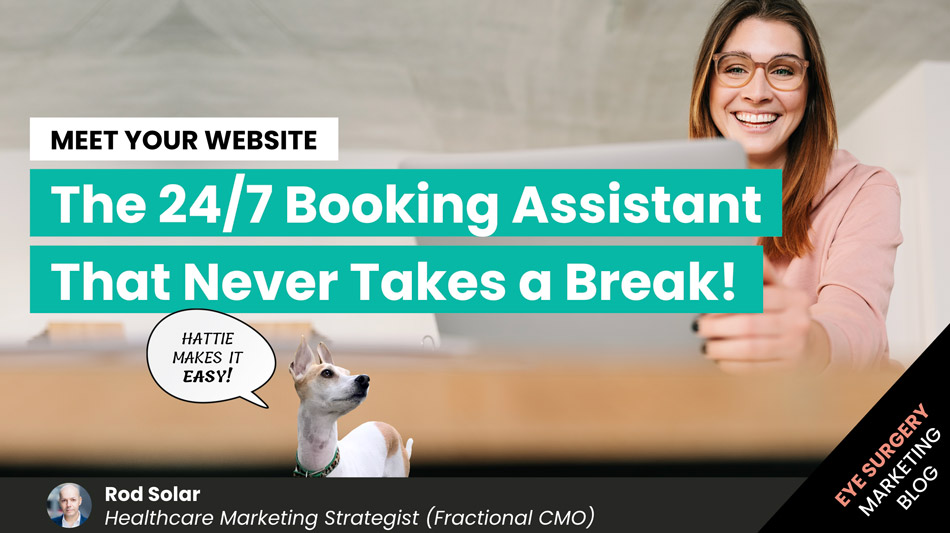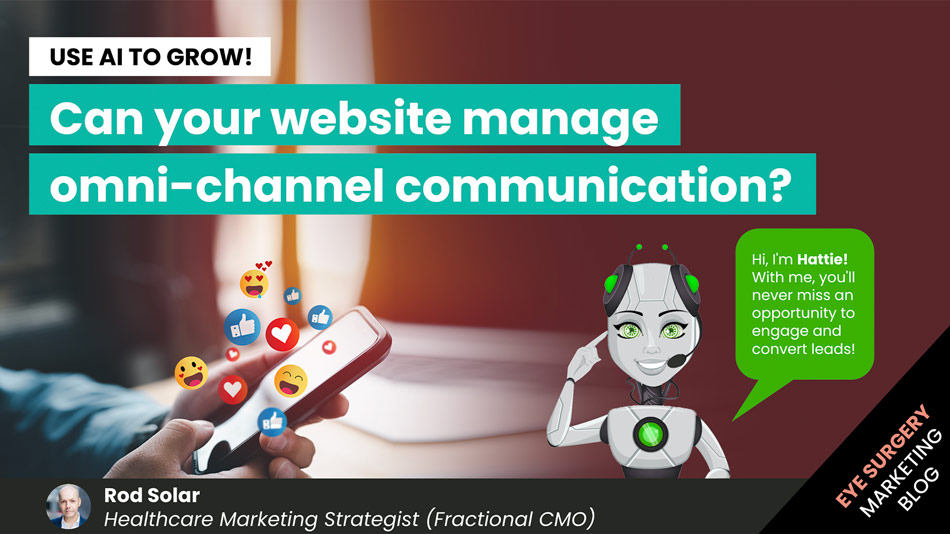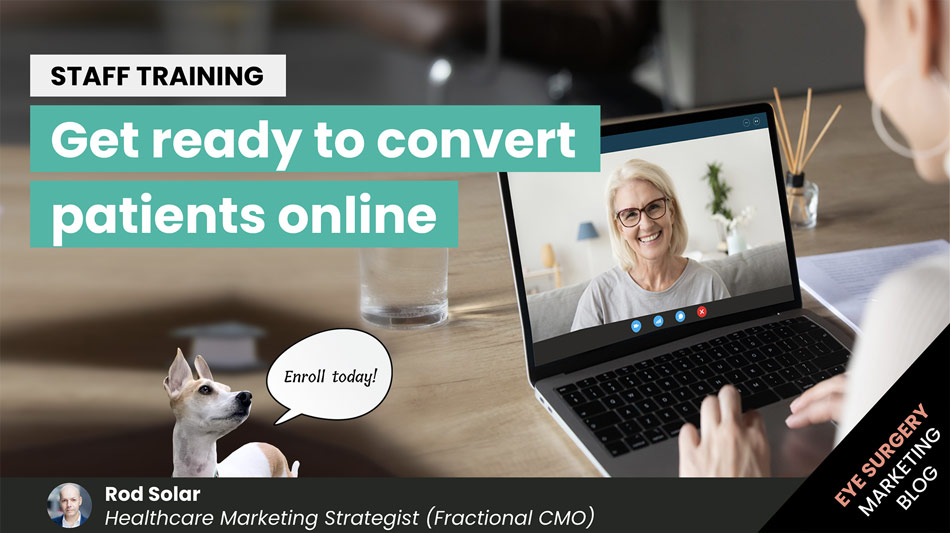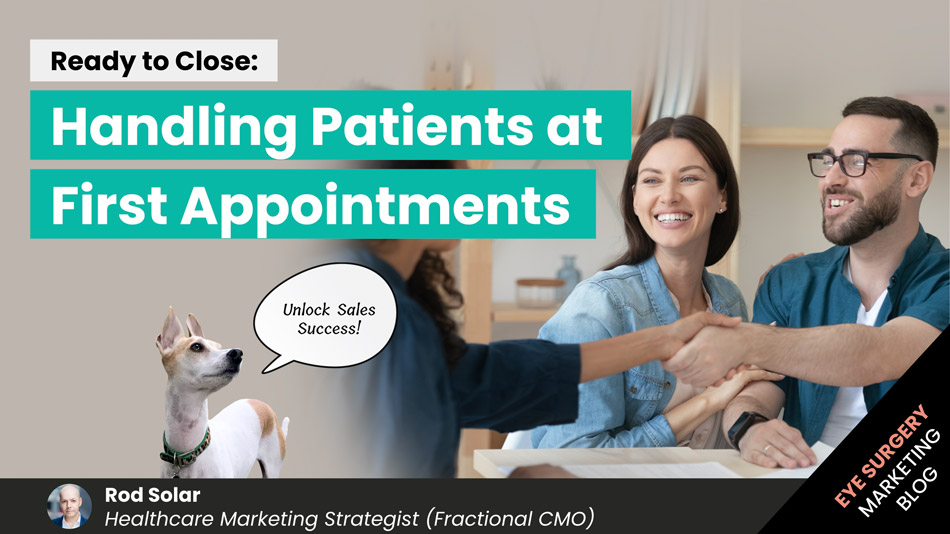What are you really selling?
Rod Solar:
So I have a little news for you. Nobody really wants what it is that you think you’re selling. They want something completely different. What they want is to be transformed from who they were before they saw you, to who they want to become after they see you.
Now this is a fundamental concept that we really, really attempt to emphasise with every single person that we work with is to really understand what marketing is.
Marketing is the articulation, whether it’s usually through writing, writing is your biggest friend here, through graphics and through all sorts to acts of service, to get them from point A to point B.
That’s what it’s all about.
Transform your patient from A to B
And I think that a lot of people stall at the stage. For example, let’s say I run a laser eye surgery practice and I know that my customers have glasses or contact lenses and they want to get rid of them.
So what I as a laser eye surgeon is I help them get rid of their glasses and contact lenses and now they don’t have them anymore. Ta-da! I’m in business. But it goes a little bit further than that, doesn’t it?
Laura:
Mm, absolutely. Nobody wants that.
Rod Solar:
Nobody wants that.
Laura:
Nobody wants to buy a laser. Nobody wants to buy an “ophthalmologist’s services”, which sounds crazy. They really don’t want your services. They have no interest in that. And we can’t hammer this home because everybody’s website is talking about, here’s what I offer. I have laser eye surgery. I have this amazing laser. Here’s what I offer. I’m a chiropractor. You come in, you buy sessions from me.
Rod Solar:
I have this really cool technique.
Laura:
Yeah, yeah, yeah. Here’s what I offer. I’m a dermatologist. I’m going to check your skin. Nobody cares about that. That is not what you should be focused on. What people want is (as Rod said), to be transformed, but they want transformation. They want you to take them from feeling sad and upset and for example, with a skin rash, I’m feeling sad. I’m feeling upset. I’ve got this thing that’s making me not go out, not want to see my friends because I’m embarrassed.
To (on the flip side), feeling like I’ve got my life back again. I’ve taken control of my skin. I’m in the driver’s seat. It’s actually a massive change.
Rod Solar:
I’m now a confident, effervescent individual who can take on anything and feel free to interact in loads and loads of situations without fear of what people think of me. So you might not imagine that you are in the psychology business, but everybody in business is in the psychology business.
Laura:
And so how we do that and how you’re going to want to do that is [to] think about your marketing, in terms of talking about what somebody has before they run into you. Basically, before they have your service, and what somebody has after.
And Rod’s going to break down for you what you need to think about in the before stage and what you need to think about in the after stage to get at that psychology so that you can speak a language that potential patients actually understand.
What do your patients have in the ‘before’ stage?
Rod Solar:
So the first thing you got to think about is what people have.
What do they have now before and what will they have after?
And fortunately, like I said earlier, with the example of laser eye surgery, most people operate at that level. They can get that. So let’s take an example in plastic surgery.
What do they have now?
Well, right now they might have an asymmetrical nose or they might have a saggy face. Okay. That’s what they have now. So what do they have after you’ve treated them? Well, now their nose is symmetrical, it’s straight, perhaps it’s smoother and maybe their face is lifted, and they look more youthful.
Okay. That’s what they have after. Terrific. Great foundation. Good first step. But that is absolutely not where it ends. Next, we have to think about what do they feel?
So what do they feel before? Well think about how their asymmetrical nose makes them feel? A lot of young women for whom this is an issue, they might have lived with their nose (misshapen in their opinion, or in reality,) for potentially a decade. And what happens? Well, they feel very, very insecure about it. They feel like they have never once been considered beautiful. They feel sad that nature and genetics has dealt them a hand, that they have absolutely no way of controlling.
There’s no amount of exercise, there’s no amount of makeup, there’s no amount of artifice that can hide that nose that they hate so much. It’s all about those feelings.
What’s their desired after state?
So where do they want to go? Well, how do they want to feel? is the next question you have to answer. So you have to imagine in your avatar, what is the opposite of how they feel right now?
They want to feel beautiful. They want to feel confident. They want to feel like they can do whatever they want and be the person who they most want to be without the handicap of this, in their view, facial deformity and having a nose, one of the things that people most notice at first in anybody’s face that holds them back in life.
That’s how they feel. That’s how they want to feel. And if they can see you as a guide to get them from point A to point B, then you’re golden because that’s exactly-
Laura:
Nobody else is helping them do that.
Rod Solar:
Precisely. I mean, that’s great. I have a misshapen nose and I get a straight nose, fantastic (and most people get that). However, you got to go to the feeling level and you got to do that in copy. What I mean by that is in writing.
Writing is your biggest friend in all of this messaging.
Put yourself in the position of your avatar
Now the next level, it goes further. The next level is you got to think about what’s their average day like? So I want you to put yourself in a position of your avatar (and that can be hard), let’s say for example, you’re a 50, 55, 60 year old male consultant, maybe you’ve had a teenage daughter (maybe you haven’t). But it really, really helps to get close to your avatar because then you’d know that their average day is perhaps composed of hiding from social situations, being in the background, rarely putting themselves forward. In a group-
Laura:
Considering all the angles for photos.
Rod Solar:
For photos or not even wishing to appear in photos at all. Or when the teacher calls upon the students to answer a question, do they raise their hand? No, because they don’t want to call attention to themselves.
So that’s their average day. It’s hiding in the shadows, being in the background, feeling ugly, for lack of a better word. These are their words that they’ll use.
By the way, a really, really good way to understand feelings and daily experiences is by reading testimonials, your own testimonials and the testimonials of others. They say it. They lay it all out. They explain exactly what their daily lives were like. And if you can capture that in copy, well, you’ve really gone a long way towards appreciating who they are and how they feel-
Laura:
Making them feel understood and heard and gotten, which I think is just a general human need to feel like somebody gets you.
Rod Solar:
Yeah. So then, what do we do for their average day in the future?
Well, the average day of somebody who basically has forgotten that their nose even exists. That’s what they want. They just want to forget that that nose is even there. And so once you’ve actually facilitated the rebuilding of that nose and you make their nose wonderful and they love it, then all of a sudden they’re appearing in selfies. They’re being more courageous. They’re being more confident. This could lead them to loads and loads of places where they might not have gone before. They might be far more willing to put themselves forward at job interviews. They might be far more interested in getting on the dating scene and meeting that partner for life. They might be much, much more keen on applying for that promotion and potentially moving forward in their career.
That’s what you’re selling.
Now think about this for a moment: When you’re selling a procedure that’s worth, perhaps, or that’s priced at, about 6,000 pounds, do you think you could sell it for a thousand pounds or a few thousand pounds more if you spoke in this way? And, made what it is that you offer so intricately tied to what matters most in their lives?
Do you think you can sell that for a little bit more and you get a lot of price rejection on that? Absolutely not.
All of a sudden it’s like, “let’s tear down the barriers and let me add it because that’s what I want”.
Now, the other thing that after that, after the average day is status.
So how do they feel other people see them? Because status is a massive component in all of our lives because we’re social creatures. So when it comes to status is:
How does the world see me? (And you can talk about that in copy).
And how does the world see me after? (You can talk about that in copy).
There’s loads and loads of daily life aspects that are inhibited by our perception of our own appearance.
Make the patient the hero of their own story
Finally, we want to get at to what we call good versus evil. Everybody in their lives sees themselves as the hero of their own story.
And this is really very important because you’ve got to use that knowledge to tune in to how they see where you fit in their story. And you’re not the hero.
Pro tip: you’re not the hero. You’re the guide.
We’ll explain that in a few moments. But initially what you need to do in the ‘before’ state is you have to understand: How do they see themselves in the narrative?
Are they the victim? Or are they the courageous person who is going to break out of their shell?
And all they need is just a little bit of reassurance, just a little bit of guidance in order to get to that level? And then after, how are they going to see themselves in their story? They are now the hero. They are now the person they’ve always wanted to become. They’ve crossed the challenges and now have come out the other side and they are now everything who they want to be. They’re the perennial hero of every story. That’s what everybody wants.
Apply this principle to the core of your brand
So you have got to consider all of this and you got to communicate it in your website, in your emails, in your social media, in your advertisements, in your graphics, you got to do all of that in every way you communicate. If you think about this before and after grid, if you like of kind of what I painted out here, that’s exactly what you want to focus most of your communication on.
Not the facts, not the specific intricacies of your techniques, not the lasers or the techniques, or (sorry), the tools that you use. Not your special methods, not your training, not your experience.
No, no, no, no, no. All of that is background. All of that is nice to know later. What’s needed to know is before and after and how that relates to the specific patient, which leads us to the hero of the story.
So do you want to just introduce the concept of the story brand? Because I think that would be super useful for these folks to know.
What does ‘the hero’ mean?
Laura:
Yeah. Yeah. So continuing on from this idea of ‘hero’ is, let’s take a step back, and just think about who is normally the hero in most medical practices? Historically, it’s being the doctor.
Rod Solar:
This is simple to see, all you gotta do is look at their websites.
Laura:
Yes, exactly. So I think, again, we can think about this if what we’re trying to do here is compete. What we’re trying to do here is connect with our potential patients. If you think about making yourself the hero, that’s not something that’s going to provide much connection with the potential patient. But if you think about a potential patient wanting to be the hero of their own lives and you actually put them in that position and you basically allow them to be guided through a process, this is something that’s very powerful.
So if you think about almost every movie you’ve ever seen, whether it’s Star Trek or Star Wars, there’s always a reluctant hero, and this really is at its foundation you may have heard about Joseph Campbell and this hero mythology and running through our culture and running through everything that we do.
Well, this is very much alive and well in marketing.
And so we really advocate looking at your business in this journey process and looking at taking your patient from being this reluctant hero, from understanding what their challenges are, from empathizing with them and from being the guide, much like Luke Skywalker had a guide to take him through his journey.
You become that guide to help them go from the before state to the after state.
And I think Rod you’re really good at explaining how that whole process works. And I think it would be great if you could summarise that.
NOTE: The best way to answer that nagging question about practice growth or marketing or patient volume in the back of your mind is to book a free 15-minute compatibility call. Get some options and go away with a clear idea of what’s possible.
The Luke Skywalker story
Rod:
Sure. Well, let me take you through, you know, you gave me the good idea, Luke Skywalker story. Okay. Everybody knows Luke Skywalker from Star Wars.
So he starts up as a lonely farm boy in the middle of Tatooine, basically working on the farm and not really loving his life so much. What does he do? He looks up at the sky. He dreams about the stars. He imagines himself as a hero out there, potentially doing wonderful things, joining the rebel alliance and defeating the empire.
Okay, great. So this is a classic setup. And then the same thing when it comes to the Lord of the Rings, same things when it comes to The Matrix. You think about any movie and it’s pretty much like this and why? Because we’re conditioned to understand stories.
Just like Laura said, we’re conditioned to understand stories on this basis. Now what does Luke Skywalker do? First of all, he imagines his future and then he decides, “Nah, it’s not for me. I’m not good enough. I don’t have the ability. I don’t have the training. I’m not up to it.” So there’s a refusal of the call. So typically the hero is called to action in some way. And basically that’s what you’re doing with your patient.
You’re saying: “Hey, patient, I need you to think about taking the next step.” And they will refuse the call. And the people always refuse the call because the lack of confidence, they don’t have that self confidence to take the next step. And so you need to provide them with the means that are really, really easy to take that next step.
So what does the guide provide them? I got a plan. Look, here’s how it works:
You call me, we have a conversation, then you come and see me. I figure out what I can do for you. I give you all the facts. Number three, I treat you. Problem solved. You’re now the hero.
So that’s a very, very simple guide plan. And that’s what you need to provide to your patients everywhere. Right on the website, first thing, it’s like the hero shot. Picture your patient in the main hero shot of the website, that’s who you have to picture.
Laura:
Not you.
Rod:
Not you.
Laura:
Not your team.
Build that hero story into your brand
Rod:
No matter how good looking you are! Not your team. And then underneath that, you say:
“This is what I do for my heroes. My heroes are you. And here’s how I guide my heroes to get what they want.”
That’s what your initial headline’s about. Then, you gotta make sure you let people know, who is it for? So are you a potential hero that I can help? Are you like this? Are you like this? Are you like that? Those are your avatars. Okay. See how it’s all coming together? Your customer avatars are your heroes in the making. Then you act as the guide to lead them through that process. And when you think about your marketing in this way, when you think about your messaging in this way, it changes everything in terms of how you contextualize what you do.
Laura:
And it stops you from focusing on selling you and your services. And we’re going to go full circle to not remind you, but just I hope that you’ve become convinced that it’s really, your services are not important in this whole game.
Your services are really not what people are after. They’re after transformation. And there’s a process that you can use to get them from the before state to the after, which is the hero that they wanted always to become. And that’s really what you’re offering, which is massive. And I hope that you can get excited about that and create a vision around your business that allows people to become heroes.
About the author

LiveseySolar
LiveseySolar’s mission is to double the size of 150 cataract and refractive surgery practices. Using our proven marketing frameworks and deep market knowledge, our customers can predictably and sustainably grow their practices so that they can enjoy a healthy balance between both worlds – a successful private practice and a happy life.
Related Posts
Meet our Co-Founders
We’re passionate about helping leaders of high-quality, growth-minded practice owners double their practice revenue
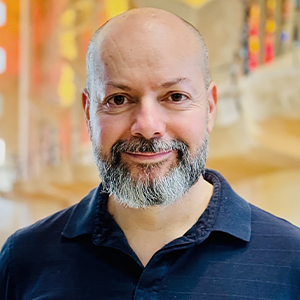
Rod Solar
Founder & Scalable Business Advisor
For over 20 years, I’ve helped ophthalmology entrepreneurs scale their private practices. I specialise in doubling revenue within three years by offering a proven framework, hands-on experience, and a team of experts who implement what works. We take the guesswork out of growth and scale, so you can focus on delivering exceptional patient care while maximising the value of your business.
LiveseySolar completely transformed the way we were approaching this… We’ve gone from having just the dream of having a practice to having a practice up and running with people making inquiries and booking for procedures… It’s extremely pleasing. We feel lucky we connected with LiveseySolar.
— Dr Matthew Russell, MBChB, FRANZCO, specialist ophthalmic surgeon and founder of VSON and OKKO

Laura Livesey
Founder & CEO
I’m the co-founder & CEO of LiveseySolar. I’ve developed powerful eye surgery marketing systems that increase patient volumes and profits for doctors, clinics, and hospitals, since 1997.
Rod and Laura know as much about marketing surgery to patients as I know about performing it. They are an expert in the field of laser eye surgery marketing. They know this industry inside out. I believe that they could help many companies in a variety of areas including marketing materials, sales training and marketing support for doctors.
— Prof. Dan Reinstein, MD MA FRSC DABO, founder of the London Vision Clinic, UK






